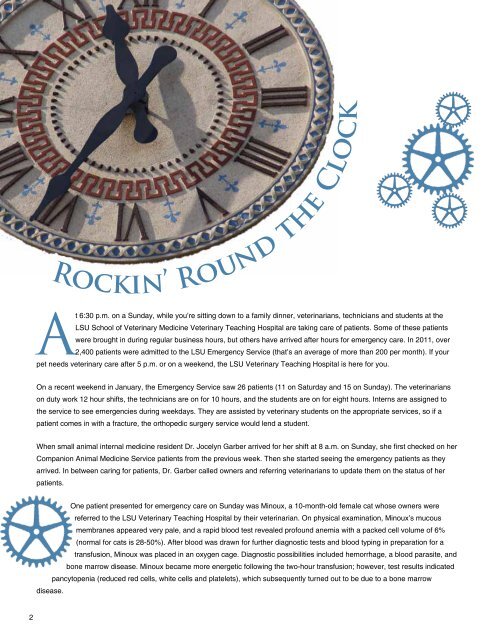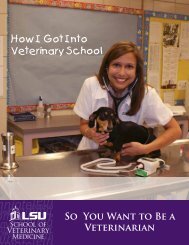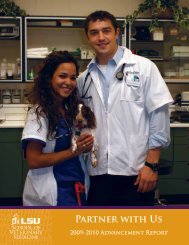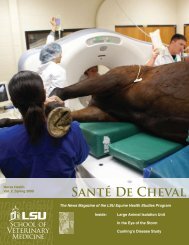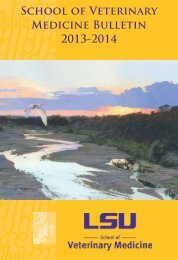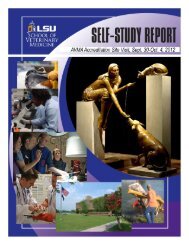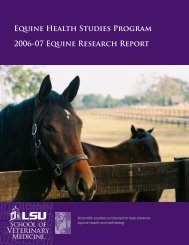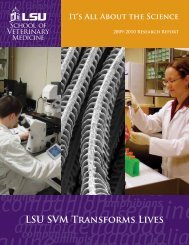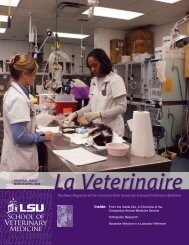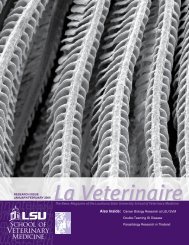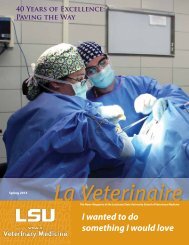Rockin' Round the Clock - School of Veterinary Medicine - Louisiana ...
Rockin' Round the Clock - School of Veterinary Medicine - Louisiana ...
Rockin' Round the Clock - School of Veterinary Medicine - Louisiana ...
You also want an ePaper? Increase the reach of your titles
YUMPU automatically turns print PDFs into web optimized ePapers that Google loves.
Rockin’ <strong>Round</strong> <strong>the</strong> <strong>Clock</strong><br />
At 6:30 p.m. on a Sunday, while you’re sitting down to a family dinner, veterinarians, technicians and students at <strong>the</strong><br />
LSU <strong>School</strong> <strong>of</strong> <strong>Veterinary</strong> <strong>Medicine</strong> <strong>Veterinary</strong> Teaching Hospital are taking care <strong>of</strong> patients. Some <strong>of</strong> <strong>the</strong>se patients<br />
were brought in during regular business hours, but o<strong>the</strong>rs have arrived after hours for emergency care. In 2011, over<br />
2,400 patients were admitted to <strong>the</strong> LSU Emergency Service (that’s an average <strong>of</strong> more than 200 per month). If your<br />
pet needs veterinary care after 5 p.m. or on a weekend, <strong>the</strong> LSU <strong>Veterinary</strong> Teaching Hospital is here for you.<br />
On a recent weekend in January, <strong>the</strong> Emergency Service saw 26 patients (11 on Saturday and 15 on Sunday). The veterinarians<br />
on duty work 12 hour shifts, <strong>the</strong> technicians are on for 10 hours, and <strong>the</strong> students are on for eight hours. Interns are assigned to<br />
<strong>the</strong> service to see emergencies during weekdays. They are assisted by veterinary students on <strong>the</strong> appropriate services, so if a<br />
patient comes in with a fracture, <strong>the</strong> orthopedic surgery service would lend a student.<br />
When small animal internal medicine resident Dr. Jocelyn Garber arrived for her shift at 8 a.m. on Sunday, she first checked on her<br />
Companion Animal <strong>Medicine</strong> Service patients from <strong>the</strong> previous week. Then she started seeing <strong>the</strong> emergency patients as <strong>the</strong>y<br />
arrived. In between caring for patients, Dr. Garber called owners and referring veterinarians to update <strong>the</strong>m on <strong>the</strong> status <strong>of</strong> her<br />
patients.<br />
One patient presented for emergency care on Sunday was Minoux, a 10-month-old female cat whose owners were<br />
referred to <strong>the</strong> LSU <strong>Veterinary</strong> Teaching Hospital by <strong>the</strong>ir veterinarian. On physical examination, Minoux’s mucous<br />
membranes appeared very pale, and a rapid blood test revealed pr<strong>of</strong>ound anemia with a packed cell volume <strong>of</strong> 6%<br />
(normal for cats is 28-50%). After blood was drawn for fur<strong>the</strong>r diagnostic tests and blood typing in preparation for a<br />
transfusion, Minoux was placed in an oxygen cage. Diagnostic possibilities included hemorrhage, a blood parasite, and<br />
bone marrow disease. Minoux became more energetic following <strong>the</strong> two-hour transfusion; however, test results indicated<br />
pancytopenia (reduced red cells, white cells and platelets), which subsequently turned out to be due to a bone marrow<br />
disease.<br />
2


